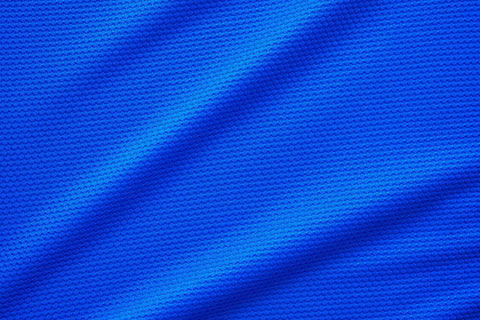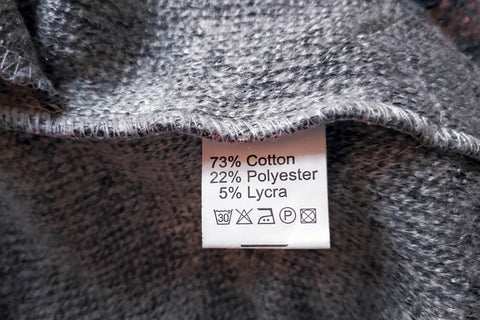
The characteristics of polyester fabric make it one of the most popular textiles around.
Table of Contents
What is Polyester Fabric?
Polyester is a synthetic (man made) type of fabric, made out of a composition of petrochemicals. It’s one of the most popular and widely-used textiles on earth. You will almost certainly have plenty of clothes and furnishings made out of polyester fabric in your home right at this moment.
What Is Polyester Fabric Used For?
Polyester is a popular fabric to make clothing out of. In fact, it’s not uncommon for an item of clothing to be 100% polyester. But that’s just the tip of the iceberg. Here are some other examples of things you can make out of polyester:
| Clothing | Homeware |
| Shirts | Towels (bath, kitchen, face, etc.) |
| Trousers | Blankets |
| Suits | Upholstery |
| Jackets | Curtains |
| Gym gear | Chair cushions |
| Socks | Pillows |
| Underwear | Sofas |
Polyester also has industrial applications and uses — for example, to make holographic film and LCD displays along with many other things — it’s an incredibly versatile product!
What Can I Make With Polyester?
The sky’s your limit with polyester fabric as it can be used to make almost anything. A great way to cut your teeth on a polyester DIY sewing project might start with the following:
-
Baby bibs — as polyester is water-resistant, easy to clean and available in a lot of different prints.
- Head wear — for example scrunchies and headbands with fabric flowers to decorate.
-
Kitchen furnishings — oven mitts, aprons, and towels are all convenient and straightforward projects that will make great gifts.
-
Upholstery covers — for duvets, pillows, and more.
- Organisers and pouches — ideal for storing things away, such as stationary, and protecting items (you can make a good DIY laptop sleeve with polyester).

Polyester fabric is the textile of choice when it comes to sporting garments, here you can see ‘breathing holes’ to aid with perspiration.
What Does Polyester Feel Like?
Polyester has a coarse, almost silky feeling to it. Yet it can also feel slippery to touch. It tends to cling to your skin, where it also traps sweat against the skin. This quality makes it the material of choice for sporting teams, but can also make it feel a bit sticky in hot weather. On the other hand, a polyester garment will feel warmer in cold weather.
Properties Of Polyester: Advantages, Disadvantages & Characteristics
Polyester fabric stands on its own. That being said, it is also sometimes blended with cotton fabric or another natural fibre to make it softer and more comfortable. This process of blending with another fabric can enhance the garment with polyester’s special characteristics. For example, a garment made out of both cotton and polyester is less likely to shrink, less likely to crease, and more likely increase in durability/last longer.
Is polyester a good material? Here is a quick view into the advantages, disadvantages and characteristics of polyester fabrics.
| ✓ | X |
| Durable | Not breathable |
| Flexible | Can generate static electricity |
| Moisture-resistant | Not suitable for some skin types |
| Easy to look after | May retain odours |
| Low-cost | Not eco-friendly |
| Crease-resistant | |
| Colours do not fade | |
| Moisture-wicking properties | |
| Moth & mildew resistant |
Different Types Of Polyester Fabrics:
There are many different types of polyester fabric. Including:
-
Ethylene polyester — Also known as PET, this is the most common type you’re likely to encounter on the market.
-
Plant-based polyester — This uncommon type of polyester is biodegradable, making it one of the more preferable types to use because it has less of an ecological footprint.
-
PCDT polyester — this type is a bit like PET, however it has more elastic properties. It’s more suited to home furnishings, for example, pillow cushions or curtains.
Within these three types, there are common blendings of polyester fabric that you can utilise for different effects in your sewing projects. Including:
-
Fleece polyester — Along with fleece fabric, this soft, cosy variant feels very warm and is commonly used for winter-weather garments including jumpers, hats and blankets.
-
Twill Polyester — An effective type of suit fabric, this variation utilises a diagonal weave pattern and is good for making durable tailored garments such as trousers, jackets and skirts.
Read more: What is suit fabric? A brief introduction.
-
Satin polyester — Polyester combines with satin fabric for a smooth, shiny and elegant finish. Ideal for formal wear, or for lining fabrics.
-
Chiffon & georgette polyester — With chiffon & georgette fabric, you can create delicate, light clothes with a coarse texture. Popular examples include scarves, blouses and flowy dresses.
- Jersey polyester — For stretchy, smooth and comfortable gym wear or jumpers, jersey & stretch fabric is an ideal material to match it up with.

Polyester is often blended with other fibres for maximum comfort and practicality.
Similar, Alternative Fabrics To Polyester
There are a few alternatives to polyester that you might want to check out, including lycra fabric and linen fabric.
Lycra is both a moisture-wicking and durable synthetic fibre, making it good for gym wear. It too is blended with other materials to enhance their properties. If you want the qualities of polyester, but with more stretch and recovery, you might want to check out lycra.
Linen on the other hand, is of natural-origin. But it shares some qualities with polyester. Including durability and moisture-wicking. Cotton fabric, while not exactly like polyester, is also a common alternative many people opt for.
Is Polyester Eco-Friendly?
It isn’t particularly eco-friendly. While some polyester is biodegradable, for the most part it isn’t. Most critics would agree that it has a bad environmental impact, but because the fabric is so durable one could argue that it’s more sustainable in the long-run over other natural fibres. That is, if you take into account savings in water usage and energy consumption over time.
A Brief History Of Polyester Fabric
Polyester has its origins in both the USA and UK. In the 1920s, research was carried out in the United States into the creation of synthetic fibres. This work soon inspired scientists in Britain to conduct studies of their own, resulting in the creation of the first ever polyester fibre, known as Terylene.
The Americans soon purchased the right to produce polyester, and began doing so in large quantities, which marked about the time when it became widely available on the market.



3 commentaires
Your website is very inspiring with high-quality content. We are sure that you will find additional useful information on our website. Come on, visit us at Konveksi Seragam Kerja and we can collaborate with each other.
Warm Regard.
Your website is very inspiring with high-quality content. We are sure that you will find additional useful information on our website. Come on, visit us at Konveksi Seragam Kerja and we can collaborate with each other.
Warm Regard.
Your website is very inspiring with high-quality content. We are sure that you will find additional useful information on our website. Come on, visit us at Konveksi Seragam Kerja and we can collaborate with each other.
Warm Regard.